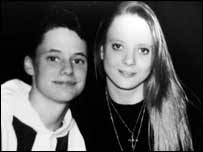Hate Crimes Against Queer Youth
Copyright (c) by Dina Mazina and Rebecca DiBrienza, 2008. All rights reserved.
Violence against queer individuals, although tragic, has often served as a powerful springboard for LGBT activism. In the past 15 years popular media has prominently focused on two particular hate crime victims, Brandon Teena, a transgender man killed in Humboldt, Nebraska, and Matthew Shepard, a gay male killed in Laramie, Wyoming.

Brandon Teena was born Teena Brandon in 1972 in Lincoln, Nebraska. Sometime after puberty, Teena began rejecting her own sex and living as a man, adopting the name Brandon. At the time of his death in 1993, he was living in Humboldt, Nebraska and had begun dating Lana Tisdale, the former girlfriend of local ex-convict John Lotter, one of the people Teena had been socializing with in Humboldt, who would later become his murderer. Lotter and Marvin Nissen, the other killer, were “outraged at their inability to categorize him” and chose to resort to violence. Prior to the murder, they forcefully removed Teena’s pants in order to expose his sex, and proceeded to drive him to a remote location and rape him.
Brandon escaped from Lotter and Nissen and reported the rape to the authorities. The sheriff’s interrogation was reportedly abusive and critical and focused more on Teena’s gender identity than on the actual crime. About a week later, on New Year’s Eve, Lotter and Nissen shot Teena, along with friends Lisa Lambert and Phillip DeVine, as they had threatened to do if the rape was ever reported. The three were found dead in Lambert’s home. [2]
The case received little mainstream media attention until the beginning of Nissen’s trial, when articles appeared in The Advocate, The Village Voice, and, surprisingly enough, in Playboy. [3]In the days following the murder, young LGBT activists began organizing in response to the event, demanding “greater civil rights protection.” [4] The Oscar-nominated film Boys Don’t Cry, featuring Hilary Swank and based in the murder, turned Brandon Teena into a prominent queer figure.

Matthew Shepard, a 21-year-old student at the University of Wyoming, became a symbol for the effects of homophobia when he was brutally assaulted and left for dead on October 6, 1998. Shepard had left a meeting of the University’s LGBT Association and gone to get a drink alone at a bar. The assailants, Aaron McKinley and Russell Henderson, posed as gay and lured Shepard outside. They proceeded to torture and pistol-whip him and left him bound to a fence. He was found 12 hours later by a cyclist and admitted to a hospital in critical condition. He died on October 12.
The murder received an immediate onslaught of media attention and propelled activists to organize in political, social, and artistic ways. In the following years, an openly gay mayor, Guy Padgett, age 27, was elected in nearby Casper, Wyoming. Equality Wyoming, a gay rights group, and Link, a support group for LGBT youth, both started during the aftermath of Matthew Shepard’s death. Openly gay theater director Moises Kaufman and his Tectonic Theater Company based in New York City, went to Laramie and recorded 400 hours of interviews, which were eventually turned into a play. The Matthew Shepard story was also made into two television movies, one for NBC and one for HBO. [6]
References
- ↑ http://newsimg.bbc.co.uk/media/images/39517000/jpg/_39517997_brandonlana203.jpg.
- ↑ “Transgendered community remembers the death that sparked a movement.” December 28, 2003. November 27, 2007. http://www.cnn.com/2003/US/Central/12/28/brandon.death.transgender.ap/ Helvie, Sherri (1997). Willa Cather and Brandon Teena: The politics of passing. Women and Language, 20(1), 35-40. Retrieved November 29, 2007, from Research Library database. (Document ID: 13355971).
- ↑ “Transgendered community remembers the death that sparked a movement.” December 28, 2003. November 27, 2007. http://www.cnn.com/2003/US/Central/12/28/brandon.death.transgender.ap/ Helvie, Sherri (1997). Willa Cather and Brandon Teena: The politics of passing. Women and Language, 20(1), 35-40. Retrieved November 29, 2007, from Research Library database. (Document ID: 13355971).
- ↑ http://www.cnn.com/2003/US/Central/12/28/brandon.death.transgender.ap/
- ↑ http://en.wikipedia.org/wiki/Image:Matthew_Shepard_head_shot.jpg#file
- ↑ Guy Trebay (2005, December 18). "Cowboys, Just Like In the Movie." New York Times (Late Edition (east Coast)), p. 9.1. Retrieved November 30, 2007, from National Newspaper Abstracts (3) database. (Document ID: 943019391). Matthew Shepard Foundation. “Matthew’s Story” November 27, 2007. http://www.matthewshepard.org/site/PageServer?pagename=mat_Matthews_Life Swigonski, Mary E., Mama, Robin Sakina, and Kelly Ward. From Hate Crimes to Human Rights: A Tribute to Matthew Shepard. New York: Herrington Park Press, 2001. Stockwell, Anne (2002, March). "Looking for Matthew: The Laramie Project traces a hate crime's deep impact on ordinary people's lives". Review of medium_being_reviewed title_of_work_reviewed_in_italics. The Advocate,(859), 56. Retrieved November 30, 2007, from Research Library database. (Document ID: 581492031).